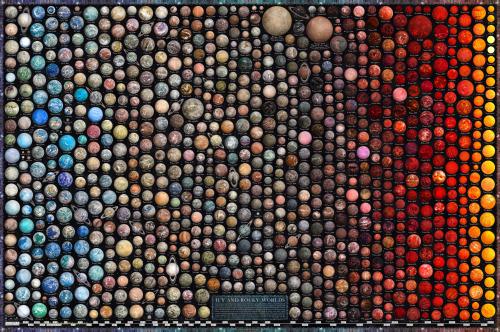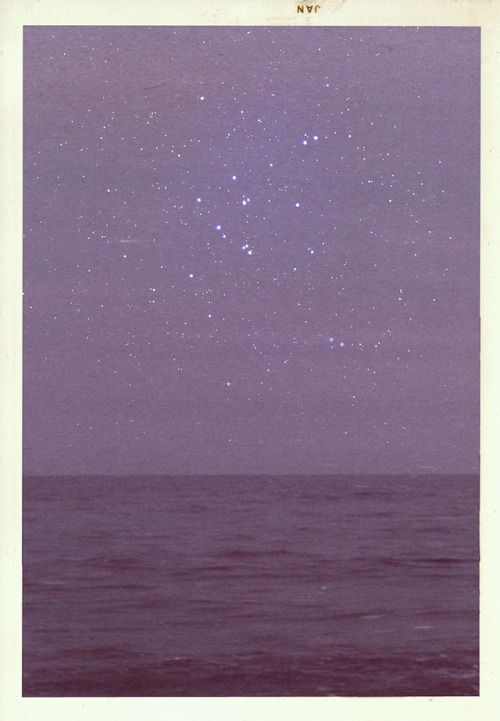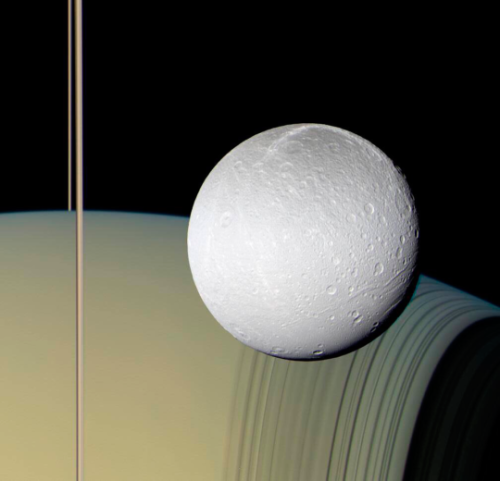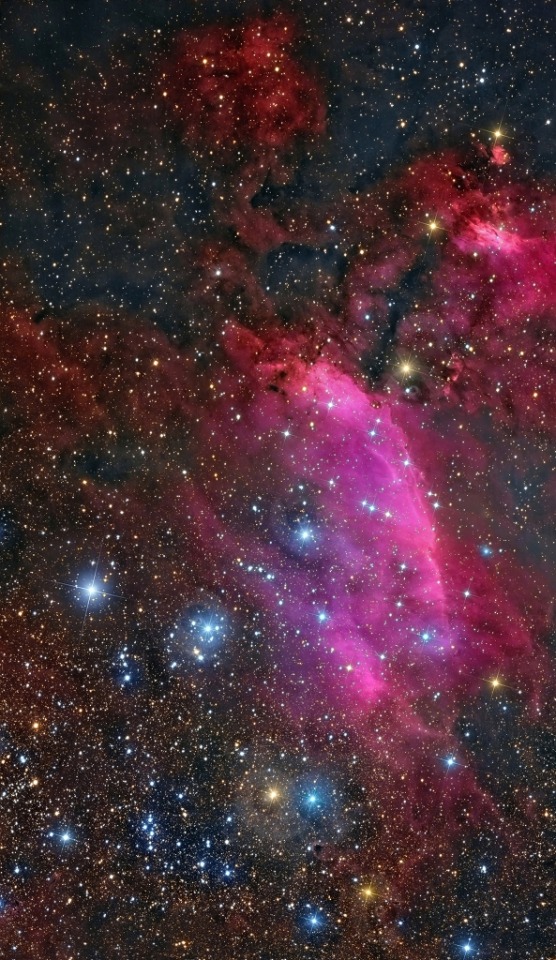SPACEMAS DAY 2 ✨🪐🌎☄️☀️🌕

SPACEMAS DAY 2 ✨🪐🌎☄️☀️🌕
There's a new space telescope in the sky: Euclid. Equipped with two large panoramic cameras, Euclid captures light from the visible all the way to the near-infrared. It took five hours of observing for Euclid's 1.2-meter diameter primary mirror to capture, the 1000+ galaxies in the Perseus cluster which lies 250 million light years away. More than 100,000 galaxies are visible in the background, some as far away as 10 billion light years. Euclid's initial surveys, covering a third of the sky and recording over 2 billion galaxies, will enable a study of how dark matter and dark energy have shaped our universe.
Image Credit: ESA, NASA
More Posts from Ad-astra-affecte-spe and Others

Over 800 terrestrial exoplanets visualized and arranged according to their equilibrium temperature and size.
chart by u/mVargic

The red planet. Presidential design awards 2000.
Internet Archive

Over 800 terrestrial exoplanets visualized and arranged according to their equilibrium temperature and size.
chart by u/mVargic

The glittering globular cluster Terzan 12 — a vast, tightly bound collection of stars — fills the frame of this image from the NASA/ESA Hubble Space Telescope. This star-studded stellar census comes from a string of observations that aim to systematically explore globular clusters located towards the centre of our galaxy, such as this one in the constellation Sagittarius. The locations of these globular clusters — deep in the Milky Way galaxy — mean that they are shrouded in gas and dust, which can block or alter the wavelengths of starlight emanating from the clusters.
Here, astronomers were able to sidestep the effect of gas and dust by comparing the new observations made with the razor-sharp vision of Hubble's Advanced Camera for Surveys and Wide-Field Camera 3 with pre-existing images. Their observations should shed light on the relation between age and composition in the Milky Way’s innermost globular clusters.
[Image Description: The frame is completely filled with bright stars, ranging from tiny dots to large, shining stars with prominent spikes. In the lower-right the stars come together in the core of the star cluster, making the brightest and densest area of the image. The background varies from darker and warmer in colour, to brighter and paler where there are more stars.]Credit:
ESA/Hubble & NASA, R. Cohen (Rutgers University)


Francesco Levy, The Constellations of Summer



Mars painting by Herb Herrick for an article about terraforming in World Book Science Annual 1975. Consultant: Carl Sagan. The first painting (top) is followed by two clear plastic overlays of the skies and rain and finally plant life.

an actual true color photograph showing Saturn, its rings, and one of its moons taken by the Cassini space probe orbiting 23.8k miles away, October 11, 2005
-
 karfild liked this · 9 months ago
karfild liked this · 9 months ago -
 kyrillas reblogged this · 10 months ago
kyrillas reblogged this · 10 months ago -
 gwe1954 liked this · 11 months ago
gwe1954 liked this · 11 months ago -
 images-of-all-kinds reblogged this · 1 year ago
images-of-all-kinds reblogged this · 1 year ago -
 xploseof reblogged this · 1 year ago
xploseof reblogged this · 1 year ago -
 kutabare-a liked this · 1 year ago
kutabare-a liked this · 1 year ago -
 ashleighxcx reblogged this · 1 year ago
ashleighxcx reblogged this · 1 year ago -
 ted-blogs-blog liked this · 1 year ago
ted-blogs-blog liked this · 1 year ago -
 kyrillas reblogged this · 1 year ago
kyrillas reblogged this · 1 year ago -
 srry2bother liked this · 1 year ago
srry2bother liked this · 1 year ago -
 the-yearning-astronaut reblogged this · 1 year ago
the-yearning-astronaut reblogged this · 1 year ago -
 eric9dean liked this · 1 year ago
eric9dean liked this · 1 year ago -
 godwiniamnot liked this · 1 year ago
godwiniamnot liked this · 1 year ago -
 richwall101 liked this · 1 year ago
richwall101 liked this · 1 year ago -
 luigi-hc-444-blog liked this · 1 year ago
luigi-hc-444-blog liked this · 1 year ago -
 ad-astra-affecte-spe reblogged this · 1 year ago
ad-astra-affecte-spe reblogged this · 1 year ago -
 himinme liked this · 1 year ago
himinme liked this · 1 year ago -
 will-0-wsps liked this · 1 year ago
will-0-wsps liked this · 1 year ago -
 nch1982 liked this · 1 year ago
nch1982 liked this · 1 year ago -
 spayki liked this · 1 year ago
spayki liked this · 1 year ago -
 horrorbloodylover liked this · 1 year ago
horrorbloodylover liked this · 1 year ago -
 dekard7990 liked this · 1 year ago
dekard7990 liked this · 1 year ago -
 ashleighxcx liked this · 1 year ago
ashleighxcx liked this · 1 year ago -
 joshocatboy reblogged this · 1 year ago
joshocatboy reblogged this · 1 year ago -
 joshocatboy liked this · 1 year ago
joshocatboy liked this · 1 year ago -
 soltantounsogno reblogged this · 1 year ago
soltantounsogno reblogged this · 1 year ago -
 soltantounsogno liked this · 1 year ago
soltantounsogno liked this · 1 year ago -
 jimmyjgw liked this · 1 year ago
jimmyjgw liked this · 1 year ago -
 love-is-pain-by-bri liked this · 1 year ago
love-is-pain-by-bri liked this · 1 year ago -
 jscript85 liked this · 1 year ago
jscript85 liked this · 1 year ago -
 naranci0ne liked this · 1 year ago
naranci0ne liked this · 1 year ago -
 mark9999 liked this · 1 year ago
mark9999 liked this · 1 year ago -
 nightwolf057 liked this · 1 year ago
nightwolf057 liked this · 1 year ago -
 tropicaldream29 reblogged this · 1 year ago
tropicaldream29 reblogged this · 1 year ago -
 tropicaldream29 liked this · 1 year ago
tropicaldream29 liked this · 1 year ago -
 ik-de-zwarte-kat reblogged this · 1 year ago
ik-de-zwarte-kat reblogged this · 1 year ago -
 recycledaesthetic77 reblogged this · 1 year ago
recycledaesthetic77 reblogged this · 1 year ago -
 alniilam liked this · 1 year ago
alniilam liked this · 1 year ago -
 awesomeatomiccollector liked this · 1 year ago
awesomeatomiccollector liked this · 1 year ago -
 xploseof liked this · 1 year ago
xploseof liked this · 1 year ago -
 bonefra86 liked this · 1 year ago
bonefra86 liked this · 1 year ago -
 kaifyer reblogged this · 1 year ago
kaifyer reblogged this · 1 year ago -
 dcclxx777vii reblogged this · 1 year ago
dcclxx777vii reblogged this · 1 year ago -
 andromeda1023 reblogged this · 1 year ago
andromeda1023 reblogged this · 1 year ago -
 andromeda1023 liked this · 1 year ago
andromeda1023 liked this · 1 year ago -
 jcsms liked this · 1 year ago
jcsms liked this · 1 year ago

★•Astronomy, Physics, and Aerospace•★ Original and Reblogged Content curated by a NASA Solar System Ambassador
204 posts


